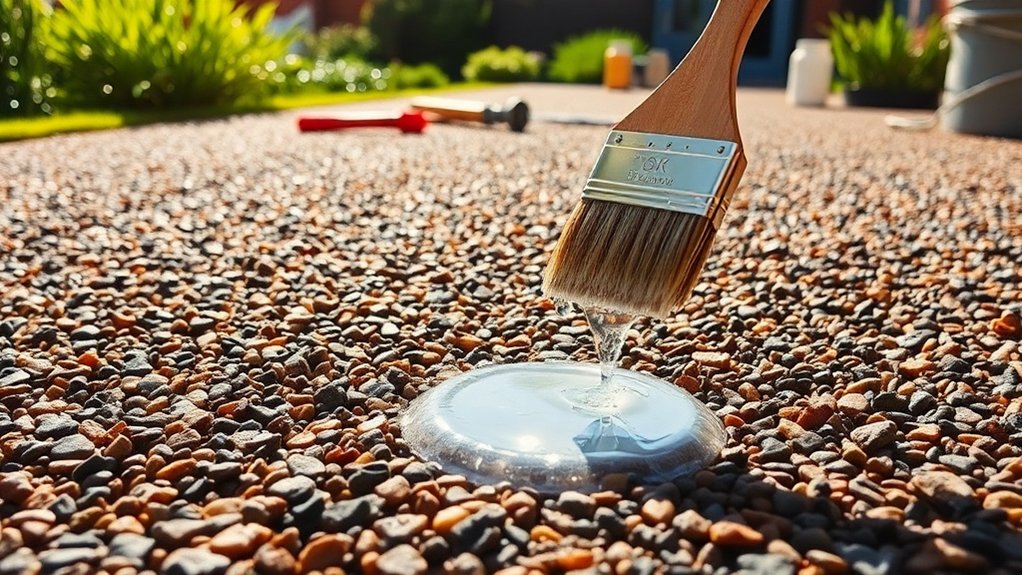To apply protective coatings on resin-bound gravel, start by choosing a robust, UV-resistant sealant that’s suitable for your materials. Ensure the surface is clean and dry before you begin. Use a brush or roller for even application. Once the coating is applied, allow sufficient time for it to cure properly, ensuring strong adhesion. Regularly check the surface for any damage or signs of wear, and plan to reseal every 3 to 5 years for optimal performance. Further details on these steps are available if needed.
Key Takeaways
- Select an appropriate protective coating, such as polyurethane or epoxy, ensuring it is compatible with both the resin and aggregate materials.
- Prepare the surface by thoroughly cleaning and drying it to ensure the coating adheres effectively.
- Apply the coating using methods like brushing, rolling, or spraying, making sure to distribute it evenly across the resin and aggregates.
- Allow adequate curing time post-application to ensure strong adhesion and durability of the coated gravel surface.
- Carry out regular maintenance and inspections, and consider resealing every 3 to 5 years to prolong the lifespan and improve the appearance of the gravel.
Importance of Protective Coatings
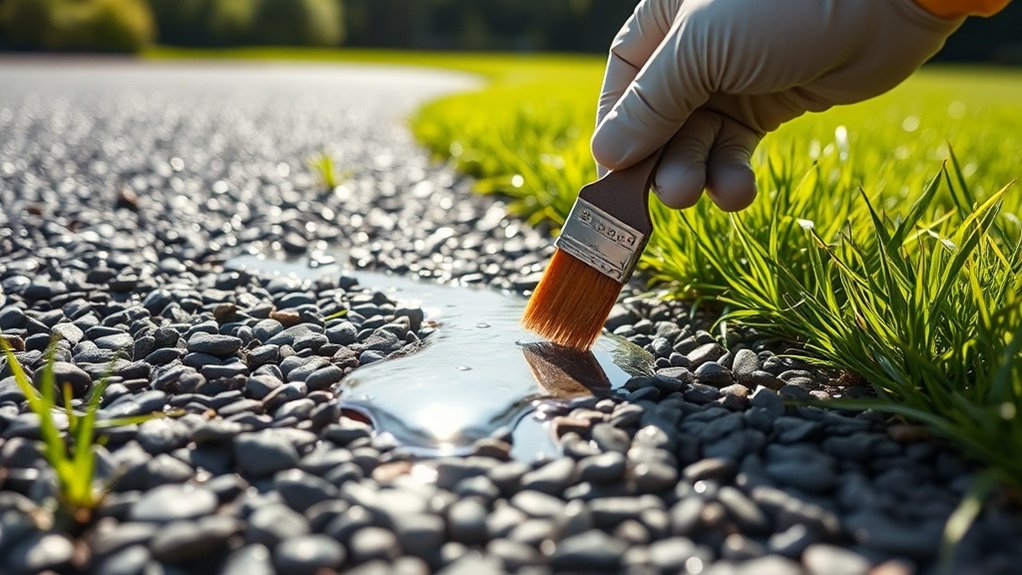
The importance of protective coatings on resin-bound gravel can’t be overstated. They significantly enhance erosion resistance and surface stability. By securely binding the aggregates, these coatings help prevent stone displacement and soil erosion, especially in areas prone to heavy rain or freeze-thaw cycles. Additionally, protective coatings can improve water permeability by ensuring that the resin-bound gravel continues to function effectively as a sustainable drainage solution.
Notably, resin-bound gravel’s 95% permeability enhances its effectiveness as an eco-friendly surface. These coatings act as a barrier against harsh weather, stopping gravel loss and soil washout while still allowing for natural drainage. This permeability helps reduce surface water runoff, which in turn mitigates flood risks in urban areas and aligns with Sustainable Urban Drainage Systems (SUDS) principles.
Additionally, protective coatings extend the lifespan of gravel surfaces by minimising the need for frequent repairs, ensuring long-lasting protection.
Types of Protective Coatings Available
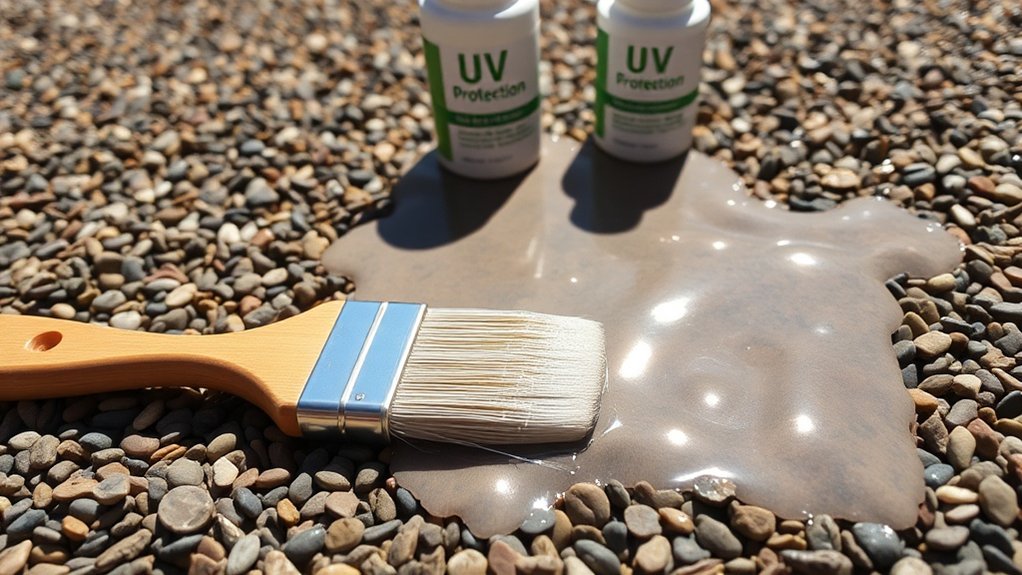
Here are four main coating types and their application methods:
- Polyurethane Resin-Based Coatings: These coatings are flexible, UV stable, and permeable, making them suitable for a range of surfaces. They are particularly beneficial because they create a strong, seamless, and cost-effective surfacing solution. Additionally, they provide long-term aesthetic longevity by preventing fading and discolouration over time.
- Epoxy Coatings: Known for their excellent chemical and heat resistance, epoxy coatings are less flexible and require precise mixing.
- Fibreglass (GRP) Linings: These offer great waterproofing and impact resistance but are rigid, making them more suitable for concrete rather than gravel.
- Anti-Slip Coatings: These coatings include additives to enhance traction, ensuring safety while still allowing for permeability.
Selecting the Right UV-Resistant Sealant
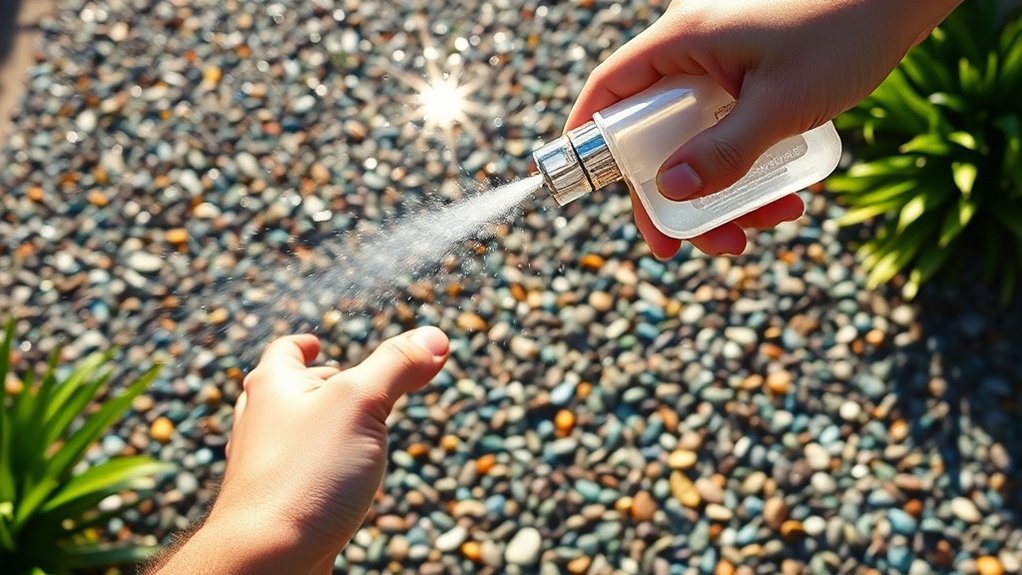
How can you ensure your resin-bound gravel is protected from harmful UV rays? Start by choosing a UV-resistant sealant that offers durability, flexibility, and moisture resistance. Check that the sealant is compatible with your resin and aggregate materials, as using mismatched products can lead to issues. It’s also important to consider weather resistance, particularly if you live in an area with extreme temperatures or heavy rainfall. Look for sealants that guarantee colour retention to keep your gravel looking good over time. Additionally, ensure that the sealant complies with Sustainable Urban Drainage (SUD) regulations to enhance the overall performance of your outdoor surfaces. Always opt for products made with recycled materials to ensure an environmentally friendly choice. Don’t forget to factor in curing time and manufacturer warranties, as these can affect long-term performance. Steer clear of common mistakes like insufficient UV protection and lack of environmental testing; always verify manufacturer claims before buying.
Application Process for Protective Coatings
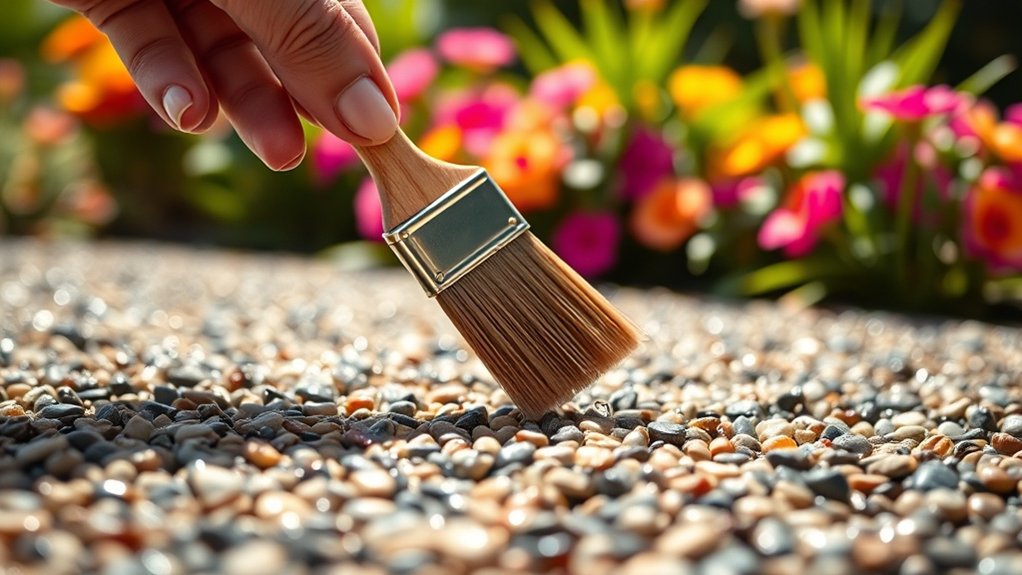
Before applying protective coatings, ensure the surface is clean, dry, and free from debris.
Choosing the right application method—whether brushing, rolling, or spraying—is crucial for achieving the best results.
Proper preparation and application techniques will significantly improve the durability and effectiveness of your coating.
For instance, if you’re painting a fence, a clean surface helps the paint adhere better and last longer.
Surface Preparation Steps
To ensure optimal adhesion of protective coatings on resin-bound gravel, proper surface preparation is crucial. Follow these key steps:
- Surface Cleaning: Clear away all debris, dirt, and contaminants using methods like pressure washing or vacuuming, making sure the surface is visibly clean and dry.
- Substrate Drying: Ensure the resin-bound gravel is fully cured by allowing at least 48 to 72 hours after installation for it to dry properly.
- Surface Profiling: Slightly roughen the surface using light sandblasting or grinding to improve mechanical adhesion, but be careful not to overprofile.
- Primer Application: Apply a compatible primer evenly, and allow it to dry until it reaches the specified tack-free state before proceeding.
These steps will enhance bonding potential, leading to a successful application of protective coatings.
Application Techniques Explained
Once the surface is properly prepared, applying protective coatings on resin-bound gravel is straightforward but requires attention to detail.
Begin by mixing the resin with aggregates uniformly, using a slow-speed drill for about a minute. Pour the mixture onto the base and spread it quickly and evenly before it sets. An adjustable-width applicator bar will help ensure even coverage and prevent over-spilling.
After pouring, level the mixture with a float, being careful not to over-trowel, as this can cause defects.
To improve slip resistance, consider adding suitable anti-slip aggregates during application. Also, keep environmental conditions in mind; work in dry weather and allow sufficient curing time to ensure strong adhesion and durability for the finished surface.
Timing Your Coating Application

Timing your coating application is crucial for achieving the best results with resin-bound gravel. To ensure maximum adhesion and durability, keep these factors in mind:
- Temperature: Aim for a range of 5°C to 30°C. Avoid extremes, as they can affect curing.
- Weather Conditions: Steer clear of applying coatings during frost, heavy rain, or high humidity; moisture can disrupt bonding.
- Forecast Check: Always check the weather forecast. If rain or dew is predicted within the next 24-48 hours, postpone the application.
- Time of Day: Midday to early afternoon is ideal as temperatures are more consistent. Avoid early mornings, especially in colder months.
Maintenance of Coated Resin-Bound Gravel
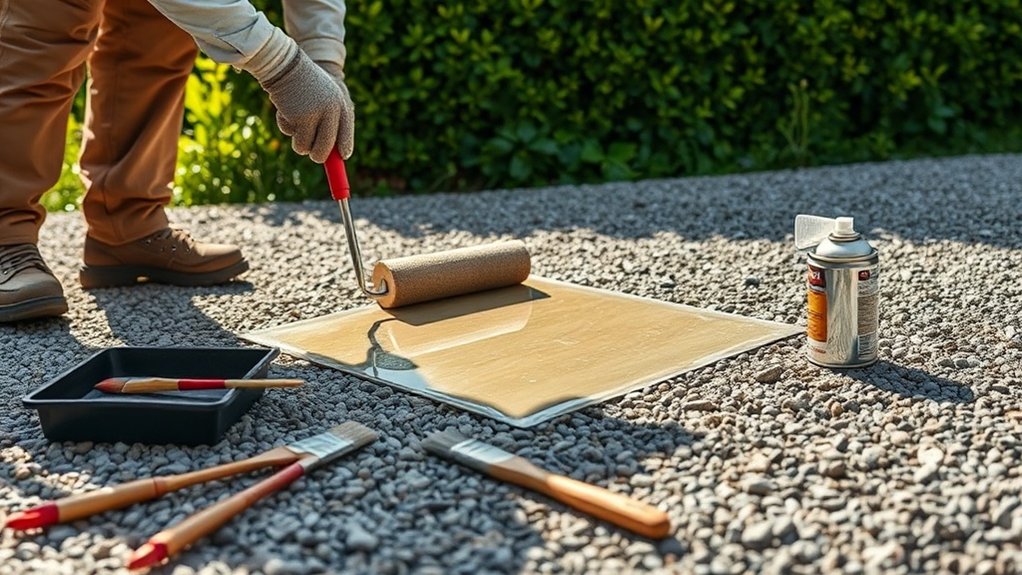
To maintain coated resin-bound gravel, carry out regular cleaning to prevent debris build-up and protect the surface.
It’s important to inspect for any damage; catching issues early ensures timely repairs and extends the life of the coating.
Follow resealing guidelines based on how worn the surface looks to keep it looking its best and performing well.
For example, if you notice fading or discolouration, it may be time to reseal.
Regular Cleaning Practices
Regular cleaning practices are vital for keeping resin-bound gravel surfaces in good condition. Neglecting these can lead to lasting damage and reduced permeability.
To ensure effective cleaning and debris removal, follow these steps:
- Sweep regularly with a stiff broom to stop debris from building up.
- Remove organic matter like leaves and twigs promptly, particularly in autumn, to prevent staining.
- Use non-metal tools such as leaf blowers for larger areas to protect the aggregate layer.
- Deep clean with a gentle pressure washer, keeping the pressure below 150 bar and steering clear of harsh chemicals.
Inspecting for Damage
Inspecting for Damage
To ensure the longevity of coated resin-bound gravel surfaces, it’s essential to carry out thorough inspections for any damage. Regular visual checks can help identify cracks, loose stones, or discolouration, which may suggest potential coating failure. Additionally, assess the mechanical adhesion by performing X-cuts and lifting sections to detect any adhesive or cohesive failures.
| Inspection Type | Key Focus Areas | Recommended Actions |
|---|---|---|
| Visual Inspections | Surface cracks, discolouration | Conduct routine checks and document findings |
| Mechanical Adhesion | Bond integrity | Perform X-cuts and use pull-off testers |
| Environmental Factors | UV damage, contamination | Clean up spills and remove debris |
| Structural Evaluation | Substrate stability | Check for cracks and ensure proper drainage |
Resealing Frequency Guidelines
Resealing coated resin-bound gravel surfaces every 3 to 5 years is essential for maintaining their protection and appearance.
The frequency of resealing can depend on several factors:
- Environmental Exposure: If your surface is in direct sunlight or experiences heavy foot traffic, you might need to reseal more often.
- Initial Reseal: For new installations, consider an initial reseal within the first two years.
- Surface Condition: If you notice a loss of gloss, it’s a sign that resealing is needed.
- Maintenance Schedule: Pair annual cleaning with resealing every 3 to 5 years to ensure long-lasting durability.
Using effective resealing methods helps keep the protective coating intact, extending the lifespan of your resin-bound surfaces and shielding them from UV damage and pollutants.
Benefits of Regular Inspections and Resealing
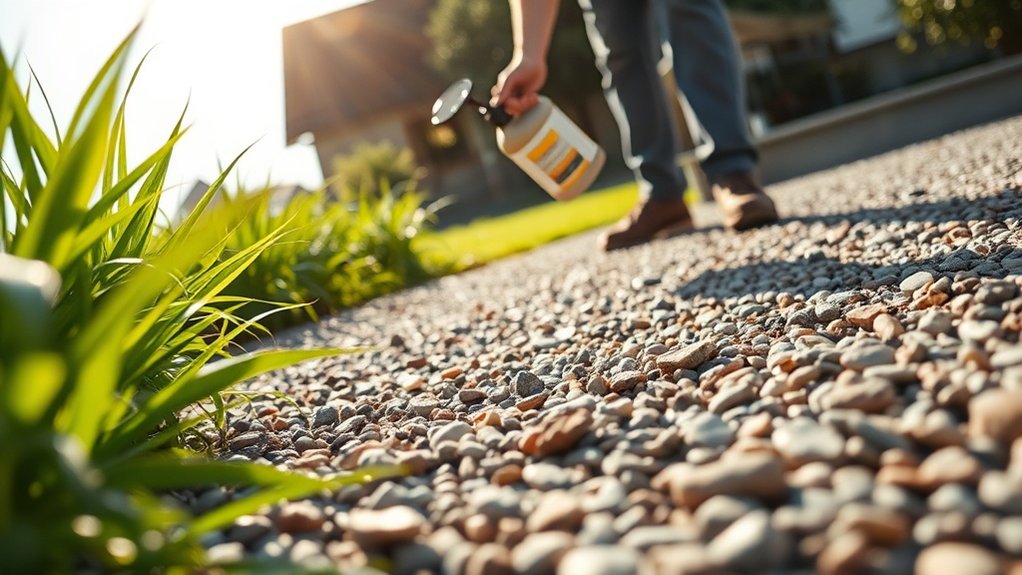
To keep resin-bound gravel surfaces in good condition, regular inspections and timely resealing are essential. Regular checks allow you to spot issues early, which can save you from expensive repairs later on.
For instance, catching cracks or damage early means you can address them before they worsen, ensuring the surface remains safe and lasts longer.
Resealing the surface not only enhances its durability but also protects it from environmental effects and spills. This process revitalises its appearance, prevents water damage, and improves slip resistance.
Overall, these practices lead to less maintenance and make cleaning easier, providing a cost-effective solution for long-term care.
Environmental Considerations for Coatings
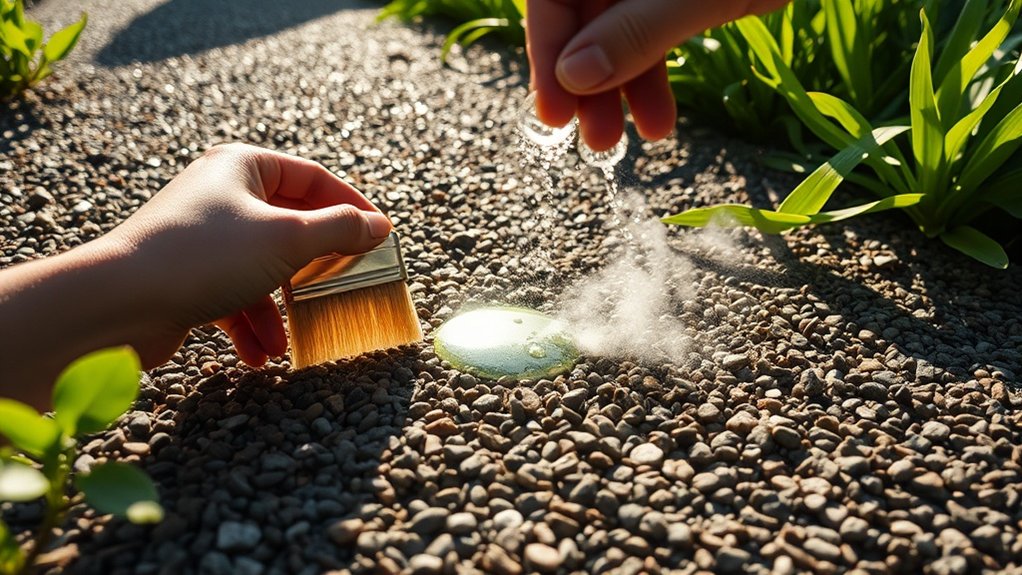
When choosing protective coatings for resin-bound gravel, it’s important to consider their environmental impact and adherence to regulations.
Here are some key factors to ensure sustainable practices:
- SuDS Compliance: Select coatings that allow water to drain naturally, helping to prevent flooding.
- Material Composition: Look for resins with low volatile organic compounds (VOCs) and non-toxic properties to reduce air pollution.
- Durability: Choose UV-stabilised coatings to extend the lifespan of your surface, minimising maintenance and resource use.
- Eco-Friendly Alternatives: Prefer bio-based resins instead of synthetic ones to reduce reliance on petrochemical materials.
Enhancing Aesthetic Appeal With Coatings
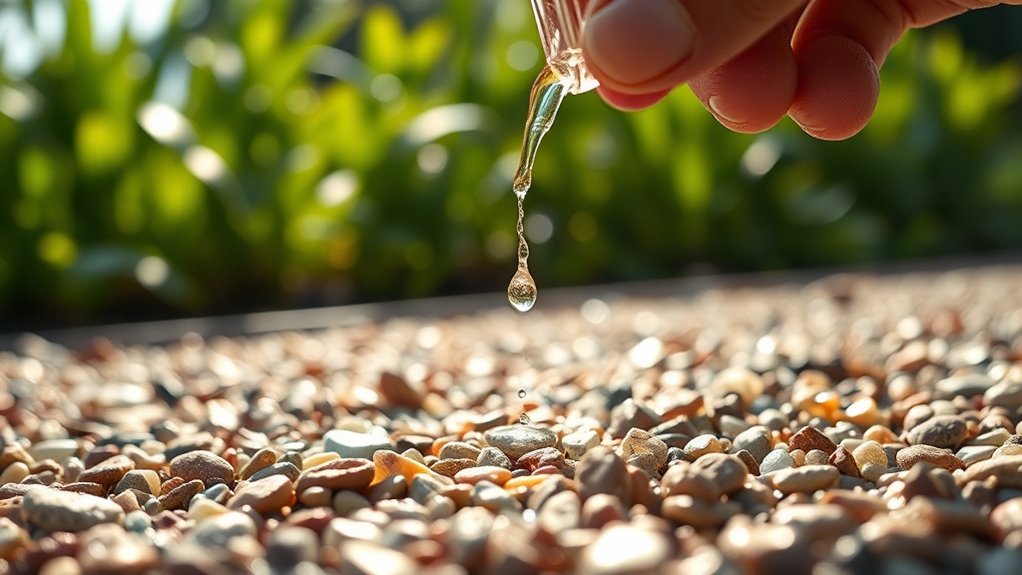
To enhance the aesthetic appeal of resin-bound gravel, you can use various protective coatings that boost both visual charm and functionality. These coatings allow you to incorporate elements of colour psychology and texture contrast, creating an inviting space. Here’s a quick overview of the key benefits of different coatings:
| Coating Type | Visual Impact | Functional Benefits |
|---|---|---|
| UV-stable | Retains colour vibrancy | Prevents fading |
| Decorative flakes | Introduces unique textures | Offers design flexibility |
| Smooth finish | Achieves a polished look | Enhances accessibility |
| Weather-resistant | Maintains surface integrity | Lowers maintenance needs |
These coatings not only improve appearance but also ensure durability and ease of upkeep, making your outdoor areas both attractive and practical.
Frequently Asked Questions
Can I Apply Protective Coatings During Winter Months?
Yes, you can apply protective coatings during the winter months, but it’s essential to keep an eye on the temperature. Ensure that the surface temperature remains above the manufacturer’s recommendations. Also, monitor moisture levels to avoid adhesion problems and inadequate curing. For instance, if it’s raining or there’s frost, it’s best to wait for better conditions.
How Long Do Protective Coatings Last on Resin-Bound Gravel?
Protective coatings on resin-bound gravel generally last between 10 to 30 years. Factors such as UV stability and the quality of materials used play a crucial role in their durability. Regular maintenance, including cleaning and resealing, can significantly enhance their lifespan and performance. For example, a well-maintained driveway could last much longer than one that’s neglected.
Will Protective Coatings Change the Color of My Gravel?
Protective coatings can influence the colour of your gravel. Some may enhance its hue, while others might change its appearance depending on how transparent the coating is. For instance, a glossy finish might make the colours appear more vibrant, while a matte finish could dull them. Always choose a coating that aligns with the look you want to achieve.
Are There Specific Brands Recommended for Protective Coatings?
Yes, consider brands like GeoBondX and DALTEX for protective coatings. Reviews highlight their UV resistance and durability, with comparisons showing clear benefits in permeability and customisation options. These make them excellent choices for resin-bound applications.
Can I DIY the Coating Application or Hire a Professional?
You can opt for DIY methods to save money and have more control, but hiring a professional ensures you get expert results and quality assurance. Consider your skills, the complexity of the project, and your budget when deciding on the best approach for your coating application. For example, if you’re repainting a room, DIY could be manageable, but for intricate exterior coatings, a professional might be a better choice.
Conclusion
In summary, applying protective coatings to resin-bound gravel is essential. Skipping this step can lead to fading and deterioration, while a properly applied sealant boosts durability and appearance. Choose a UV-resistant product and follow a maintenance schedule to keep your surface both functional and attractive. This balance of protection and aesthetics ensures your outdoor space remains enjoyable for years to come.
